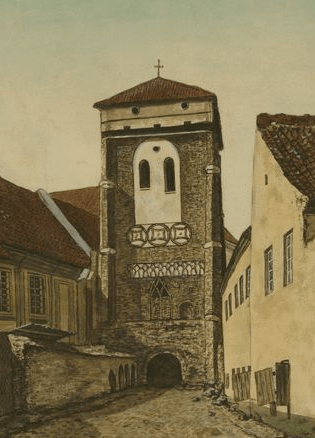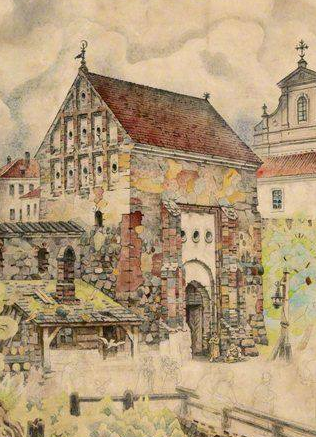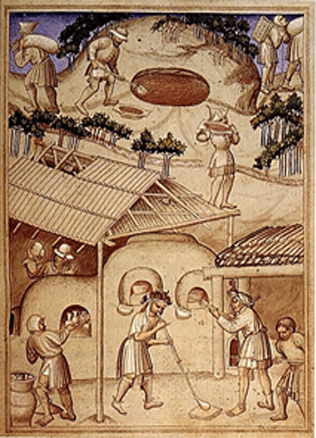Pier Paolo Vergerio and the start of Anti-Papal Reformation Polemics in Lithuania
Pier Paolo Vergerio the Junior 1489–1565) was an Italian religious activist, a hierarch of the Italian Church; upon conversion to Protestantism he exerted an influence on the early development of Reformation and Protestant thought in GDL; known as the person who launched a fierce anti-Catholic and anti-Papal polemics.
A high hierarch of the Church turned into its fierce critic
Vergerio was born in Capodistria (currently the town of Koper in Slovenia), at the centre of Istrian Peninsular, which starting with the 13th century was part of the former Republic of Venice. He studied law in Padua; having defended his doctoral thesis in utroque iure, Vergerio worked as a lawyer in Verona, Padua, Venice. From 1530 he started pursuing ecclesiastic career in the Roman Papal Curia, served as secretary of Pope Clement VII, from 1533 he was given the status of papal nuncio in the Habsburg Emperor Ferdinand’s Court in Vienna, where he became the godfather to the Emperor’s daughter Catherine von Habsburg (Katrina Habsburgska), who was to become the third wife to Sigismund Augustus, Kind of Poland and the Grand Duke of Lithuania. In 1535, Vergerio entered an active diplomatic service; he worked in Germany as the nuncio to the new Pope Paul III and met Martin Luther there. In 1536 Vergerio was awarded with the bishopric of Capodistria; he belonged to the network of the Church Hierarchy which encouraged Catholic Church reforms. Part of the network members sympathized with some of the truths of Early Evangelism which was prevalent in Italy at that time, in particular the idea of salvation by faith alone. From 1541, suspicions were raised against him as a “Lutheran” heretic, and in 1044, an ecclesiastic process was launched against him; the Bishop sought to eliminate the ecclesiastic process during the Council of Trent in 1546 but his efforts were doomed to failure. The ecclesiastical investigation lasted for a long time, until it ended in January of 1546 with the Inquisition order to arrest Vergerio. The Bishop was hiding in Italy until the spring of the same year; in May 1549, a fifty-year old Bishop emigrated to Switzerland to turn over a new leaf. He lived in Valtellina, Basel, Vicosoprano, where he became ardently involved in anti-Catholic activities as a polemist and a critic. In 1553, when he heeded a call from Duke Christoph of Württemberg to travel on behalf of Evangelical doctrine, Vergerio moved to Tübingen, Germany, where he lived and worked until his death on October 4, 1565. Vergerio started writing in Italy; however, he reached the peak as a religious publicist and a Protestant in emigration. Vergerio wrote about 150 treatises, let alone a great many other publishing projects. From the confessional point of view, Vergerio should be regarded a representative of Italian Evangelism; however, living in exile in Tübingen he advocated Lutheranism and was an active opponent of radicalism (Anabaptism, Anti-trinitarianism).
Vergerio dedicated much of his work to the people of his native Istria, thus exerting a significant influence on the development of not merely Italian but Slovenian and Serbo-Croatian religious thought and literature of the 16th century.
“Duae epistolae”: Vergerio’s and Radziwiłł’s the Black rebuff to the Catholic Church
The former Bishop of Capodistria maintained long-term cooperation with the German Dukes. However, during the last decade of his life Vergerio played the role of a Lutheranism agent and initiator of an open fight against the Catholic church in Lithuania as well. It was as early as the beginning of 1556 that Vergerio published in Tübingen the translation of Johannes Brenz’s Lutheran confession into Italian, dedicated to King Sigismund Augustus and his wife. In the same year, upon the initiative of Radziwiłł the Black, who had converted to Protestantism and maintained contact with the Duke of Württemberg, Vergerio received an invitation from Sigismund Augustus to visit GDL and Poland. In July of 1556 he made his way to Prussia and conferred with Duke Albert. In Prussia, Vergerio cherished plans to implement publishing projects targeted at the region in question. Discrediting the publication of the project launched as the fight of the Roman church against Reformation – Index librorum prohibitorum, Vergerio released in Konigsberg a certain “critical publication” of the original, Catalogus haereticorum, 1556, and dedicated it to Radziwiłł the Black. In the same year, Radziwiłł the Black received a letter from the papal nuncio Luigi Lippomano, calling upon him to denounce heresy and confirm membership of the Catholic church. Vergerio decided to use the letter as a tool enabling him to make the opposition of the most prominent GDL nobleman against the Catholic Church public. He started working on a Radziwiłł’s printed response to Lippomano. In September of the same year, having come to Vilnius, Vergerio organized printing and publishing activities of the response and prepared the final version of the book with the foreword written by himself. Vergerio presented in Vilnius the copies of Duae epistolae, printed in October in Königsberg. The treatise was shortly afterwards released in German (1557) and Polish (1559) languages; its Italian edition was also in progress.
Duae epistolae discredited Lippomano’s anti-Reformation activities in GDL and Poland, whereas Radziwiłł the Black rose to fame in Europe as a pioneer of Reformation in GDL and founder of independent Protestant church in GDL. It was due to this treatise that Radziwiłł the Black became the only Lithuanian to be included in the Roman index of Index librorum prohibitorum (1559). In his response to Lippomano, Radziwiłł the Black publicly refused to be a member of the Catholic church for the first time in the Lithuanian history, called it embodiment of evil and announced the establishment of a new, true Christian church.
Do You Know?
“My altar is by no means […] sacrilegious; it is sacred and Christian-like, not desecrated by Pontifical ungodliness and idolatry but adorned with the teachings of Christ and the Apostles. After all, it has been erected not to Mary of Rome or Loreto, not to your wooden gods and deities, which are basically Delphi devils; my altar has been erected and consecrated to the eternal living and true God.”
Unbroken ties between the Reformation thinker with the GDL
By the end of 1559 and during 1560, Vergerio visited Prussia, Poland and Lithuania again. During this period, he published several significant treatises, among them the Polish edition of the satirical anti-papal satire, the novel Historia di papa Giovanni VIII che fu femmina (History of Pope John VIII, who was a woman). On 31 January 1560, he arrived in Kaunas and stayed here for ten days, and from 8 February he visited Radziwiłł the Black in Vilnius, spending a whole month at his place. While in Vilnius, Vergerio was busy writing his treatises and fulfilling the diplomatic assignments delegated by the German Dukes.
Vergerio failed to fully carry out his mission as an agent of Lutheranism in GDL. The reason of the failure was the standpoint held by Mikołaj Radziwiłł the Black, leader of Evangelism in Lithuania. Mikołaj Radziwiłł the Black consistently promoting adherence to an independent Church. In advocating the consolidation of such Church, he was gradually drifting away from the ideas professed by the Augsburg Confession.
Having returned to Tübingen, Germany, Vergerio until his death maintained close contact with Mikołaj Radziwiłł the Black. Furthermore, from 1564 to 1565 he patronized the nobleman’s son Mikołaj Krzysztof Radziwiłł nicknamed the Orphan, who was studying in Tübingen at that time. Vergerio even dedicated some of his last treatises to him. It should be also noted that Vergerio launched an initiative to make it possible for Lithuanian young men to study at the Lutheran University of Tübingen. Thus, in 1560 the first group of young noblemen from GDL started their studies at the University, Merkelis Giedraitis, a would-be Catholic Bishop of Samogitia among them.
Literature: D. Pociūtė, Maištininkų katedros. Ankstyvoji reformacija ir lietuvių-italų evangelikų ryšiai, Vilnius: Versus aureus, 2008, p. 289–421.
Dainora Pociūtė



